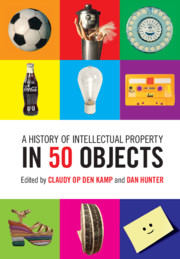Book contents
- Frontmatter
- Dedication
- Contents
- Acknowledgments
- Introduction: Of People, Places, and Parlance
- The Pre-Modern Period
- The Age of invention
- Modern Times
- The Consumption Age
- The Digital Now
- 39 Polymer Banknote
- 40 Post-it Note
- 41 Betamax
- 42 Escalator
- 43 3D Printer
- 44 CD
- 45 Internet
- 46 Wi-Fi Router
- 47 Viagra Pill
- 48 Qantas Skybed
- 49 Mike Tyson Tattoo
- 50 Bitcoin
- About The Contributors
45 - Internet
from The Digital Now
Published online by Cambridge University Press: 12 June 2019
- Frontmatter
- Dedication
- Contents
- Acknowledgments
- Introduction: Of People, Places, and Parlance
- The Pre-Modern Period
- The Age of invention
- Modern Times
- The Consumption Age
- The Digital Now
- 39 Polymer Banknote
- 40 Post-it Note
- 41 Betamax
- 42 Escalator
- 43 3D Printer
- 44 CD
- 45 Internet
- 46 Wi-Fi Router
- 47 Viagra Pill
- 48 Qantas Skybed
- 49 Mike Tyson Tattoo
- 50 Bitcoin
- About The Contributors
Summary
IN A BOOK chartered to demonstrate intellectual property in objects, what concrete thing can represent the internet, a phenomenon that exists only as a well-elaborated idea? Perhaps the best physical representation of the genius of the Internet—and in particular, “Internet Protocol”—is found in an hourglass.
Internet Protocol is the essence of today's global worldwide network, and it's a very different kind of “IP” than the one this book is about. The Internet Protocol suite is a freely available set of standards for how digital devices and the software running upon them might talk to one another, and the internet exists because the makers of those devices and software, and the networks to which they're connected, have decided to implement those standards. The internet is a collective hallucination that functions because millions of people and companies believe in it.
The hourglass on the left is from late 18th-century Italy, a time before the waisted glass shape could be blown as a single piece of glass. Instead, two glass ampules were joined by wax, covered with cloth, and secured by threads. Thatjunction, which Jon Evans calls a “bubble-gum-and-balingwire” construction, is where Internet Protocol can be found.
The metaphor of hourglass architecture is fundamental to understanding how the internet works, though its origins are a bit obscure. The US National Research Council's magisterial Realizing the Information Future: The Internet and Beyond from 1994 is one of the earlier conceptions, and it introduces the idea of a network built in layers. The number and nature of the layers has evolved over time, but its essence is three, mapping to the top, middle, and bottom of an hourglass. The bottom represents the range of physical media, wired and wireless, through which communications can take place. It's broad because it's meant to encompass any form of physical conveyance of data.
The top represents applications—what we might do when we can exchange data with one another, whether email, web browsing, or videoconferencing. It grows every time someone comes up with a new use for the internet.
And the middle is the “bearer service,” the translator that links the top to the bottom without either having to know anything about the other.
- Type
- Chapter
- Information
- A History of Intellectual Property in 50 Objects , pp. 368 - 375Publisher: Cambridge University PressPrint publication year: 2019

